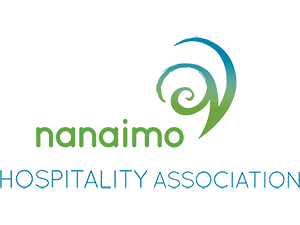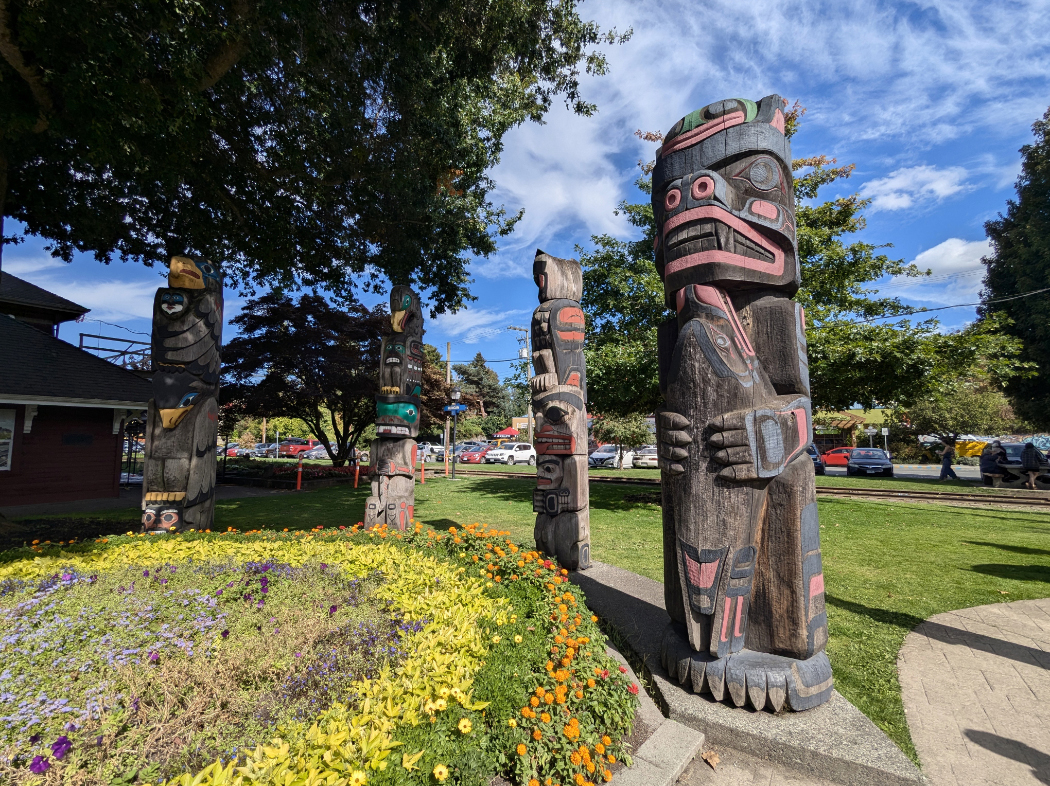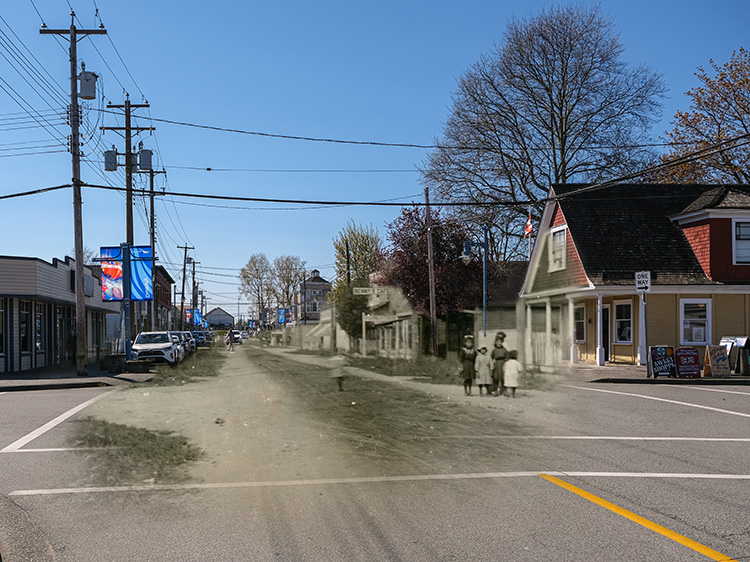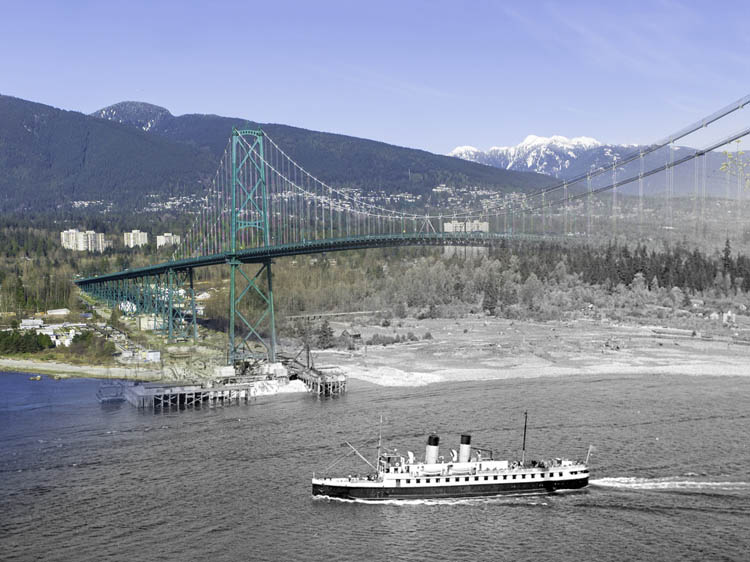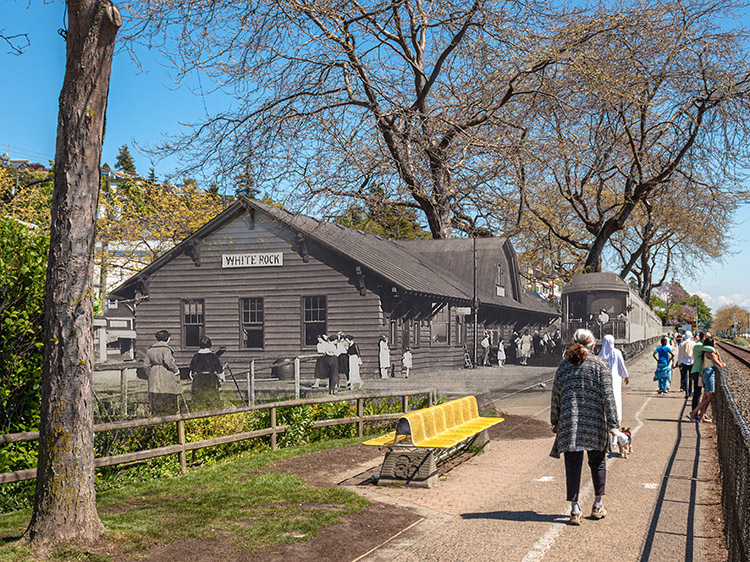Walking Tour
A Place of Healing and Rejuvenation
Saysutshun & the Snuneymuxw
Presented by Dave Bodaly

This guided tour of Saysutshun is presented by Dave Bodaly, an elder and knowledge keeper of the Snuneymuxw Nation, who have lived here since time immemorial. Come on this journey with Dave as he explains the fascinating and ancient history of the island, shares the culture and stories of the Snuneymuxw, their intimate connection with the land, and with the plants and animals that live upon it.
This project is possible with the generous support of the Nanaimo Hospitality Association and the Petroglyph Development Group of the Snuneymuxw First Nation. We would also like to thank the Nanaimo Archives and Nanaimo Museum for use of their historic photo collections and providing research assistance.
1. The Welcome Pole
We begin our tour at the welcome pole just behind Saysutshun's main wharf. Meet Dave Bodaly, our guide today. Here Dave will start off by telling you a bit about himself and the first of the fascinating transformer stories, which tell us how the animals of this region came to be.
2. Connected to the Land
As we start heading over to the head office, we can listen to Dave talk about his and the Snuneymuxw's deep and ancient connection to these lands, and the island of Saysutshun in particular.
3. Camas & Garry Oak
The garry oak trees in this grove give their name to this unique ecosystem found only in this small corner southwestern British Columbia and northwestern Washington. The garry oaks are often surrounded by fields of camas, a plant that has been part of the Snuneymuxw's way of life since time immemorial. At this stop Dave explains the importance of camas and how it was cultiuvated and gathered.
4. The Vanished Villages
There were once three Snuneymuxw villages on Saysutshun. One was located in Mark Bay. If you walk down to the water's edge and look to your right you can see where the village was once located. However, from the 1860s to the 1920s European-imported diseases devastated the Snuneymuxw and led to the abandonment of this and many other villages throughout the region.
At this stop Dave explains the impact these diseases had on Indigenous peoples, as well as the resilience they showed in the face of this trauma, and how the Snuneymuxw's population has rebounded over the last century.
5. Champagne Raccoons
Saysutshun is known for the extremely rare white or 'Champagne' raccoons that inhabit the island in some numbers. At this stop Dave explains the Snuneymuxw story of how so many of these curious creatures came to live on Saysutshun.
If you are very lucky, you might just catch a glimpse of one as you walk along the water's edge. They are most likely to be spotted on the beach in the mornings when they come out to forage for food.
6. The Sandstone Quarry
At this spot you'll find the remarkable remains of a sandstone quarry that operated on this island over a century ago. Dave tells the story of the quarry as well as the labyrinth of coal mine tunnels that once extended out beneath Nanaimo's harbour.
7. The Village in Mark Bay
If you walk to the left around the quarry and follow the path a short way into the forest, you'll come to a bluff overlooking Mark Bay. There was once an important Snuneymuxw village at the head of the bay, one of several on Saysutshun. Dave shows us the site and speaks about his deep connection to the place.
8. The Pavilion
We're now at the pavilion, which remains from this island's days as a pleasure resort operated by the Canadian Pacific Railway.
9. Douglas Fir Pitch
As we walk down this path you'll see many Douglas Fir trees towering over you. As Dave explains, the pitch (or resin) created by these trees had important medicinal uses for the Snuneymuxw.
10. The Orca Transformer
On the island's second welcome pole you can see an orca. Here Dave tells the Snuneymuxw's transformer story of how these iconic creatures came to be.
11. Life in a Longhouse
You are now standing on the site of one of the three Snuneymuxw villages that were once located on Saysutshun. You can see from the imprint in the ground that this was once the location of a longhouse. Dave explains what life in a longhouse was like for the people who once lived here.
12. Fishing for Herring
One of the main activities of the inhabitants of this village was fishing, especially for the abundant herring that passed through the narrow strait between Saysutshun and Protection Island. Dave explains the ingenious materials and techniques the Snuneymuxw used to catch these fish.
13. The Arbutus Tree
The beautiful arbutus tree is one of the hallmarks of Saysutshun. Dave explains their natural history and relation to the Snuneymux.
14. Cedar & Making Regalia
Cedar has always been sacred to the Snuneymuxw and provided for everything from sleeping mats and bracelets to canoes and longhouses. Dave continues to teach the traditional Snuneymuxw practice of using woven cedar to create regalia. Here he describes the importance of cedar, how he uses it, and the careful way he gathers it while showing respect for the trees that provide it.
15. Haunted Kanaka Bay
Kanaka Bay, which is located just down the trail from this spot, is the setting for Saysutshun's only ghost story.
16. The Salal Berry
Like many of the plants and trees found on Saysutshun, the salal berry has important medicinal properties that have been used by the Snuneymuxw since time immemorial.
17. Snake Island
The small island that is visible in the distance is known as Snake Island. Dave tells the story of how it gained its name.
18. Saysutshun's Hidden Treasure
Over 100 years ago, two Snuneymuxw men travelled to Vancouver by canoe…



